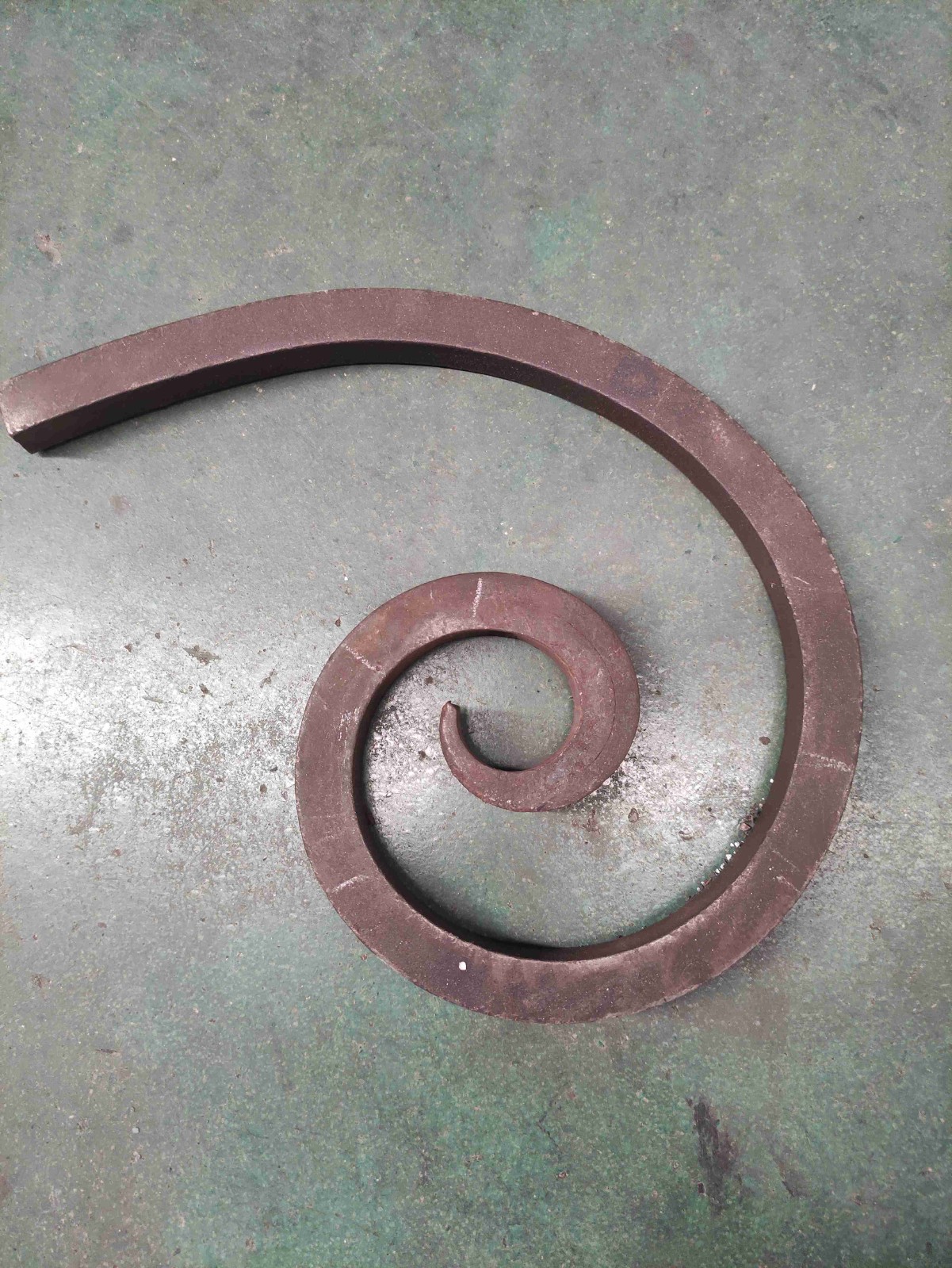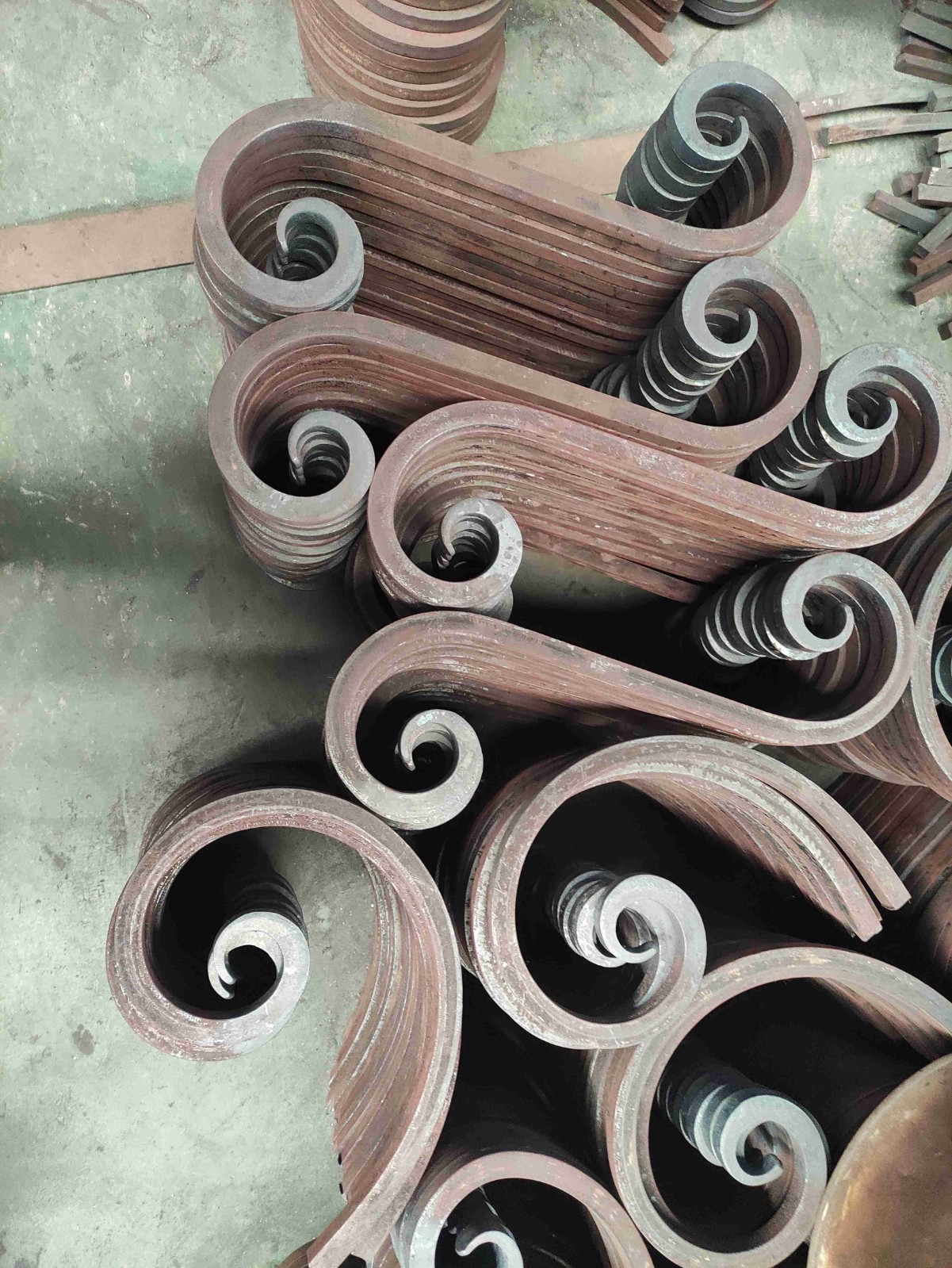Better Touch Better Business
Contact Sales at Gladman Iron Doors

Pressuring scrolls is a manufacturing procedure that press square iron bar into other components which have different shapes, sizes or performance.
 Classification
Classification
1. Rolling: A processing method that the metal blank is compressed and deformed in the gap between two rotary rolls to obtain various products. Relying on friction, the blank continuously passes through the gap between the rolls and deforms under pressure.
Main products: round steel, square steel, angle steel, rails, etc.
2. Forging: under the action of forging equipment and tools, the blank is plastically deformed to obtain forgings with a certain geometric size, shape and quality.
3. Extrusion: A processing method that the metal blank is compressed by the extrusion hole and deformed.
4. Drawing: A processing method that deforms the metal blank by being pulled through the hole of the drawing sample.
5. Stamping: The sheet metal is separated or formed under pressure between the sample mould.
6. Spinning: When the blank rotates with the mould or the spinning tool rotates around the blank, the spinning tool and the blank are fed relative to each other, so that the blank is compressed and produces continuous, point-by-point deformation.
Pressuring Methods
Common pressure processing methods include rolling, extrusion, drawing, free forging, model forging and sheet metal stamping, etc., as shown in the figure:
Pressure processing is solid-state forming, which has the advantages of good mechanical properties, less material waste, and high productivity. However, it also has disadvantages such as high processing costs, difficult forming, and inability to obtain parts with complex cavities.
Pressuring Pros & Cons
Pros:
1. High mechanical properties: compact structure, improved organization, improved performance, high strength, rigidity and toughness.
2. Save metal: less, no cutting, high material utilization. As the mechanical properties of the metal are improved, under the same force and working conditions, the cross-sectional size of the parts can be reduced, the weight is reduced, and the service life is prolonged.
3. High production efficiency: Most pressure processing methods, especially rolling and extrusion, continuously deform metal, and the deformation speed is very high, so the productivity is high.
4. A reasonable streamline distribution can be obtained (metal plastic deformation is a solid volume transfer process).
Cons:
1. The surface quality of the general process is poor (oxidation).
2. Compared with the casting method, pressure processing also has its shortcomings. Because it is formed in a solid state, the cross-sectional shape cannot be obtained, so it is impossible to form complex shapes (relatively).
3. The equipment is huge and expensive.
4. Poor working conditions (high intensity and loud noise).
Special pressure processing
The continuous development of industry has put forward higher and higher requirements for pressure processing production. For this reason, the so-called precision forming process has been gradually improved and developed on the basis of traditional forming processes, such as precision die forging, extrusion, rolling and Superplastic forming, high-energy and high-speed forming, etc.
1. Precision die forging
Precision die forging is a die forging process for forging complex-shaped high-precision forgings on ordinary die forging equipment. For example, precision die-forged bevel gears can be directly forged without cutting. The dimensional accuracy of precision die forgings can reach IT12~IT15, and the surface roughness Ra value is 1.6~3.2 μm. The characteristic of the process is to accurately calculate the original blank size, cut the blank strictly according to the quality of the blank, and carefully clean the surface of the blank before forging, adopt the low-oxidation non-oxidation heating method and strictly control the forging temperature and forging die temperature, and use high-precision forging dies. Guarantee the accuracy of forgings.
2. Extrusion
Extrusion is a plastic forming process in which a metal blank is placed in a mold cavity, and under a certain extrusion force and extrusion speed, the metal is forced out of the cavity to obtain a product of the desired size and shape. The obtained product is called an extrusion. Extrusion is not only widely used in the production of various complex cross-section profiles, but also various forgings and parts. The extrusion process can not only improve the plasticity of the metal and produce extruded parts with complex cross-sectional shapes, but also improve the accuracy of the extruded parts, improve the internal structure and mechanical properties of the extruded parts, increase productivity and save materials. Therefore, extrusion is an advanced forming method with little or no cutting processing.
3. Superplastic forming
The method of pressure processing using the superplasticity of metal materials under specific conditions is called superplastic processing. The so-called superplasticity generally refers to the phenomenon that the elongation of the material under the conditions of low deformation speed, certain deformation temperature and uniform crystal grains exceeds 100%. Any material that can exceed 100% elongation is called superplastic material. Commonly used superplastic forming materials are zinc alloy, aluminum alloy, titanium alloy and high temperature alloy. The metal in the superplastic state does not produce necking during the deformation process, and the deformation resistance is only a fraction to a fraction of the normal state. Therefore, this kind of metal is extremely easy to deform, and a variety of processes can be used to produce complex parts.
4. High-energy and high-speed forming
High-energy and high-speed forming is a forming method that releases high energy in a very short time to deform the metal. High-energy and high-speed forming mainly includes explosive forming that uses explosives to generate chemical energy, hydroelectric forming that uses electrical energy, and electromagnetic forming that uses magnetic field force.